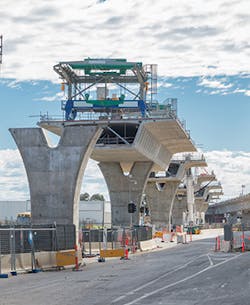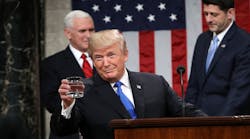Latest from Industry Trends
"This legislation represents historic progress for manufacturers and for all Americans," Jay Timmons, president and CEO of the National Association of Manufacturers, said in response to passage of the tax reform bill, which lowered the U.S. corporate tax rate from 35% to 21%. With the new bill, Timmons promised, manufacturers will "increase capital spending, expand their businesses and hire more workers…" -- and "nearly half will increase employee wages and benefits."
Tax reform is just one of a series of policy changes the Trump administration and the Republican-led Congress are seeking that business groups have lobbied for in recent years. The president has already started to push back against regulations. He is advocating a $1.5 trillion infrastructure investment which will begin to address America's aging roads, bridges and other transportation avenues. And he is calling for more "reciprocal" trade agreements that seek not simply to expand trade but to make trade more equitable.
“Any time you move work you always revisit the level of automation and how to improve it, so I think more automation is coming.” – Willy Shih, Harvard Business School
Given the direction of policy and a strengthening global economy, it's not surprising that manufacturers' optimism has soared. In the NAM Manufacturers' Outlook Survey Fourth Quarter 2017, 94.6% of respondents said they were optimistic about their own company's prospects and a solid majority (58.7%) said the U.S. was headed in the right direction. With these changes, is the long-sought U.S. manufacturing renaissance about to blossom? Manufacturing experts IndustryWeek interviewed say we're not quite there yet.
"There is reason for optimism but by no means are we back to what anybody would call an historic norm for manufacturing growth," said Cliff Waldman, chief economist at the MAPI Foundation. Between 2013 and 2016, he noted, the manufacturing sector was "almost stagnant" at about 0.5% growth on average. In 2017, it grew to 1.3%. But Waldman noted that even during the 2000s, not a great period for U.S. manufacturing, "we were seeing 2.5%, 3% at times." So far, he says, it is "a very modest improvement."
For 2018, Waldman is forecasting that manufacturing will "plod forward" at 1.5% to 2.0% growth. That's not to say he doesn't see good signs for the sector, one of which is a recent uptick in capital spending. Waldman said the U.S. has suffered for years from weak productivity growth and an underlying cause of that was the failure to invest in new technology and machinery.
"Capital spending is the way that productivity-generating innovation is spread throughout the supply chain," Waldman said.
Tax reform means that there will be less reason to move manufacturing offshore, says Willy Shih, a manufacturing expert and professor at Harvard Business School. He believes lowered tax rates will have "a bigger impact than a lot of people realize," but he cautions that decisions to build new plants in the U.S. or reshore operations won't materialize overnight. Shih also said that a decision to bring more manufacturing here does not equate to returning manufacturing sites to their former state.
Manufacturing leaders also support
the Trump administration’s promise
to take on infrastructure. In his
SOTU speech, Trump called for
a $1.5 trillion effort to “build
gleaming new roads, bridges,
highways, railways, and waterways across our land"
"Any time you move work you always revisit the level of automation and how to improve it, so I think more automation is coming," said Shih. He pointed to a variety of technologies such as simulation software and machine learning that will help companies improve the efficiency of their operations and help the move toward mass customization. At the heart of much of Industry 4.0, he said, is the move away from build-to-stock and toward build-to-order.
Better information and analytics will continue to fuel the reshaping of manufacturing, says Nick Foy, chief strategy officer at ModusLink, a provider of supply chain and logistics services. "Big data will be a driving factor throughout the year, driven by an expansion outside of the retail market which allows for more collaboration across the supply chain. Big data will have the most impact on B2B sales, which will allow it to reach further into the supply chain towards raw materials suppliers and intermediaries, ultimately allowing for faster movement of information, leading to better decision making."
Like Shih, Foy also expects manufacturers to deal with decreasing order sizes. "This continued shrinking of order sizes will allow brands to reduce inventory of finished goods, a move led by the increased prominence of postponement and near-shoring, though it will likely have the opposite 'bullwhip effect' on inventory of raw materials."
Coming Home?
Recent moves on taxes and regulation may start a pickup in reshoring, but the business and government leaders will have to overcome decades of uncertainty about manufacturing's role in America.
"The truth is, the ingredients have been in place for several years, and we still haven't seen the promised renaissance in American manufacturing," says Josh Green, co-founder and CEO of Panjiva, a big data company that analyzes global supply chains. "What's missing? Conviction on the part of executives making buying decisions that America will be a center of manufacturing in the decades to come -- and is therefore a country where they should focus their attention. Generating this kind of conviction will require a clearer definition of the specific types of manufacturing where America has a unique and enduring advantage relative to other countries around the world, as well as sustained private and public investments in the people, places, and companies that are involved in these types of manufacturing."
Manufacturers are exploring their options on manufacturing location and supply chain structures as uncertainty about trade policies rises, says Jeff McKinney, a managing director at Accenture Strategy. One issue they are examining is finding ways to bring back production to the U.S. and take advantage of consumers' preference for Made-in-America products while still keeping costs in line. He said companies are looking at a "segmented" approach to this. Rather than bring all their production to the U.S., they will bring specific products. So an apparel manufacturer, for example, may bring its high-end lines to the U.S. but continue to make clothing basics overseas.
McKinney noted that the labor cost differential between Mexico and the U.S. is still substantial. He said for a production worker in the U.S., the average labor charge is $26 to $28 an hour versus $4 to $6 in Mexico. In order to make a move to the U.S., he said, two significant cost factors to consider are the facility's footprint and automation. He said facilities can be smaller because of improved automation. A smaller factory also results in reducing labor costs and other costs such as MRO.
As for automation, McKinney says Accenture considers a dozen technologies when working with clients to determine the feasibility of reshoring. They may include mobility technology to enable a more real-time view of operations, analytics to keep machines running more effectively or advanced packaging machinery. At this point, he says, automation is not resulting in the "wholesale replacement of headcount" but is being applied tactically to "pockets" in a factory. For example, a Midwest manufacturer he works with has put in automated cells for a production process that had been conducted manually and required five to six people. Now those cells can be operated by one person.
After visiting six manufacturing plants in Illinois and the Carolinas the week we spoke to him, Jeff Owens, the CEO of Advanced Technology Services (ATS), said he found "a real energy that's building in manufacturing." But Owens said the "good problem" facing manufacturers is finding people to staff their plants after years of little or no hiring. Even as manufacturing employment increased by 196,000 in 2017, the industry faces massive dislocation as baby boomers retire and manufacturers compete with other industries for tech-savvy recruits.
ATS is not immune to this need for people. Owens said the company has been working for several years on the "people side of maintenance" through conducting "robust" recruiting, pursuing former military personnel and establishing "a lot of technical training."
ATS has also found a business opportunity in this tightening labor market. While most of its business involves long-term contracts, the company established in 2015 eFactory Services to help manufacturers who need short-term help. ATS helps with a variety of issues such as preventive/predictive maintenance services, repairable parts management, critical spares planning, supplemental maintenance and even consulting on continuous improvement projects. "Maybe it's a little more expensive, but there's no long-term commitment and people really like that," Owens observed.
More to Do
If business groups such as NAM and the U.S. Chamber of Commerce are celebrating victories on taxes and regulations, they also insist that more must be done to help their members. Trade may be the area where there is the most uncertainty and disagreement with the Trump administration.
"As the administration has pulled back on trade agreements, governments around the world have rushed forward to fill the void. The EU is striking major deals with Canada, Japan and Mexico. And the Trans-Pacific Partnership is now moving forward without U.S. involvement," U.S. Chamber President Tom Donohue noted in his 2018 State of American Business address. "This is a reminder that we are in a global competition to sell to the 95% of the world's population that lives outside of the U.S. -- and that competition goes on with or without us."
While agreeing with the push to modernize NAFTA, Donohue warned that "withdrawing from NAFTA would be a grave mistake."
Harvard's Shih points out that in the automotive sector, domestic manufacturers have moved away from vertical integration to complex supply chains with specialized suppliers. Parts move freely across the U.S. borders from Canada and Mexico. If NAFTA negotiations result in barriers to the flow of those parts, he warns, "all of a sudden you're going to cause chaos in the supply chain."
Even more challenging will be how the Trump administration handles China. Trade with China in 2017 accounted for 53% of the U.S. trade deficit, according to the latest government figure. U.S. companies still benefit from lower manufacturing costs in China, thought that differential is narrowing. And American consumers pay less for goods produced there. But trade hawks such as Scott Paul, president of the Alliance for American Manufacturing, say the U.S. has paid a huge price in American jobs for this unequal trade and the administration needs to act, not just complain about Chinese practices.
"China has yet to make a meaningful concession on its state-led mercantilism, despite two meetings between presidents Trump and Xi," Paul said after the state of the union address. "This speech won't change China's behavior and defend American jobs. Only action will. It's time for the president's policies and actions to match his talk."
Manufacturing leaders also support the Trump administration's promise to take on infrastructure. In his SOTU speech, Trump called for a $1.5 trillion effort to "build gleaming new roads, bridges, highways, railways, and waterways across our land."
AEM President Dennis Slater, who represents more than 950 manufacturers of construction, agricultural and other equipment, applauds the call for action on infrastructure. However, he said his members "want details from President Trump about his infrastructure plan, and when our industry can expect legislation to make that plan a reality."
Indeed, the details of trade deals, infrastructure, workforce training and other challenges for manufacturing lie ahead. But while the Trump team may have low marks from the U.S. electorate as a whole, many manufacturing leaders believe the president is on their side and hope he fulfills his promise to have companies and jobs "coming back."














